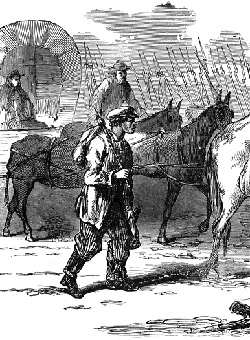
Please send all Checks and Money orders to :
Dave Taylor P.O. Box 87 Sylvania, OH 43560
419-842-1863
Click Here to E-mail Us!
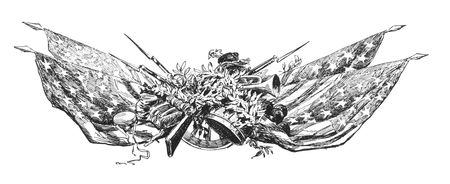
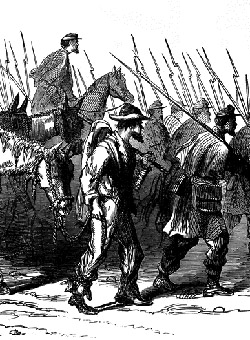
14 04

14-04-01 … Likely 21st Indiana Civil War Merrill Rifle:
One of the scarcest Civil War breech loading rifles and one with a known history of use in the field is the Merrill rifle. Only 800 or so of these arms were made by James H. Merrill in Baltimore using the same system he patented for his carbines, and the U.S. government bought 770 of them, issuing them to the 21st Indiana, parts of the 7th and 10th Michigan, 4th Arkansas, and the 1st Massachusetts. See below for data on this guns’ markings and the 21st Indiana. These are brass mounted .54 caliber rifles equipped with a patch box and bayonet lug for a saber bayonet. Ours is serial numbered 6656 on the lock plate rear of the hammer and has the very legible Merrill patent information forward of the hammer with just very slight rubbing along the top edge. Bayonet lug, bands, swivels, sights are in place. Rod is an old replacement for the Merrill buttonhead rod. Brass is light but not bright and shows a good patina, some of the screw heads show original bluing, none have gouged slots. Barrel is bright mixed with toning silver and some gray spots. Receiver shows faint smoky purple hues of faded case colors we like to see. Hammer and lock plate more silvery. Matching serial number on loading plunger and Merrill patent marks on top flat of latch. ;Rear sight leaves in place and show some faded blue. Light colored walnut stock. Wood overall is good, patch box cut out is sharp, but the gun shows the common defect in these of a horizontal crack running straight back in the wrist from the rear lock screw to the base of the receiver tang, more evident on the off side, nevertheless stable and solid. Only a few dimples otherwise on the rear belly of the butt and some minor “pings” on the inside near the buttplate. As for the evidence that this rifle was carried in the 21st Indiana, I will quote the previous owner who was quite a serious student of Merrills. He references a letter “H” in the patch box of this rifle…
“
I have (seen) or had a few others with company letters in the tool boxes. Such letters never appear in tool boxes where the rifles probably never made it south to the Hoosiers.”
(Note: many 21st Indiana Rifles have soldier’s names engraved on the trigger guards.)
“The ones with the names engraved on the trigger guards were the ones purchased out of the soldier’s own pay by Companies H and K. Others were purchased by and for the regiment and it appears that only those going to companies “H” and “I” may have been held long enough to have company letters cut in the tool box.”
End quote.
In any event, a very scarce weapon, a rare breech loading infantry rifle. I have always liked the ingenious loading mechanism. Priced friendly at
… $2,950.00
Click Here to E-mail Us!
Call us @ 419-842-1863

14-04-02 … Identified Civil War Surgeon s Amputation Kit: 4th Iowa Cavalry! …
Dr. Andrew W. McClure was 33 years-old when he enlisted as Surgeon in the 4th Iowa Cavalry on October 21, 1861. He submitted his resignation April 24, 1863, but served until June 27, 1863, part of the time acting as Brigade Surgeon. During this period the regiment served in the Army of Southwest Missouri, the Department of Missouri, and the Department of Tennessee. Surgeon McClure and his regiment served under Curtis in Missouri starting in March, 1862, making a very difficult march across Arkansas that summer against Little Rock, and then to Helena, where it remained until the Spring of 1863. At that time it took part in Grant s campaign against Vicksburg, being the only cavalry regiment with the army and acting as advance guard from Port Gibson to Jackson in front of Sherman s Corps, and then on the move from Jackson to Vicksburg holding off pursuers as part of the rear guard. As is typical of many western units it was involved in many small fights and skirmishes on top of major engagements. CivilWarData has 32 entries for dates when the regiment took casualties from the time McClure enlisted until his discharge in June, 1863. The surgical kit measures 16.5 by 9.25 by 2.5 inches, beautiful burl wood with a rectangular clipped corner escutcheon plate set in the middle of the top and brass reinforcement plates on the corners. Key locked, the case also has swivel hooks to secure it. The red velvet lined case contains two saws, three long surgical amputation knives, and a tenaculum with checkered gutta percha handles marked by Kern of Philadelphia. The tourniquet is 1860s by Tiemann, and a bone handled scalpel and second tenaculum are signed by Helmold also of Philadelphia 1860s. The tools all show use with bright metal mixed with some gray and dark spots. The gentle mixture of makers is very typical. The surgeons who practiced for many years and owned several sets, frequently consolidated the less worn tools into their best kit. Tourniquets or their cloth straps were replaced regularly due to the bloody nature of their job, and the fact that sometimes a tourniquet would be used to staunch bleeding on a wounded patient who was then tended to by another surgeon or assistant. McClure practiced medicine through the end of the 19th century. He was still active in 1898, being mentioned as a member of the Iowa State Medical Society residing in Mt. Pleasant, where he returned after his service. Civil War surgical sets are always a bit thought provoking: They bring home the reality of the war, but they symbolize the brave attempts by medical personnel on the field and often under fire to alleviate suffering and save lives. This would make a great addition to a field hospital display or if you are interested in western theatre cavalry. There is a 20th century typed note in the case that supplies the ownership history, and some data records as well
… $2,350.00 SOLD
Click Here to E-mail Us!
Call us @ 419-842-1863

14-04-03 … Very Nice US Model 1842 Musket by Springfield:
Last of the .69 Caliber smoothbore muskets, the M-1842 was also the first regulation musket in percussion and enjoyed the distinction of being the first to be made at two national armories and have interchangeable parts. This is the classic infantry weapon of the Old Army on the eve of the Civil War and was carried into action by many regiments throughout the conflict. This is an extremely nice example. Nice wood, not dinged up, gouged or scratched, good fit and good wood edges, with just the slightest rounding at points from handling. Smooth metal, scattered plum brown mixed with bright on the barrel, some very light speckling but no pitting near the bolster. Sharp v/p/eagle proof on left breech, matching 1852 tang date and 1852 lock date. Sharp lockplate markings with very visible eagle that is often rubbed, muted smoky colors on the lock and hammer. Screw slots good, nipple not battered at all. Slight vise mark at left breech. Original rod, bands, swivels, etc. all in place. Mechanically perfect. Smooth butt plate, no corrosion. No cartouche present that I can see. A superior example all in all. Great for a US martial arms collection, Civil War display, or even the early frontier army
… $1,395.00 SOLD
Click Here to E-mail Us!
Call us @ 419-842-1863

14-04-04 … Scarce “Rifled and Sighted” Harpers Ferry 1842 musket dated 1854:
A scarce example of this key US longarm. This one is a Harpers Ferry, Virginia product … significantly more desirable than Springfield specimens because of the Virginia connection. Matching 1854 barrel and lock dates which is very rare on the “rifled and sighted” versions, as they were retrofitted and reassembled without consideration by the armories as to date, or original manufacturer of the component parts. Smooth metal, mostly in the bright with some graying and dark spots. Very clear v/p/eagle barrel proofs and date, clear Harpers/Ferry/1854 lock marks behind the hammer and eagle over US forward. Lockplate and hammer silvery gray with some deeper gray areas, some areas of “nicotine ochre” as a friend of mine calls it, from years in a collector’s den. Nice metal at the breech, no pitting, good nipple not battered down. Wood generally very good, with a little shrinkage left side of the breechplug tang, a small gouge offside rear of the wrist where a soldier or owner also carved a “Mc” but never finished his name. A rack number “39” is stamped on either side of the butt flat with what might be a “D” or the body of an “I” in front of it. Some other light dings and lines, a couple of screwhead impressions from a neighboring gun, but nothing terrible. Bands, springs, swivels and proper rifled style rod in place, mechanism good. No cartouche evident. This musket was one of roughly 10,000 that were altered at the arsenals to bring them up to the standards of the 1855 series of rifled arms, by rifling the barrels and fitting long-range rear sights. This process enabling the use an elongated .69 caliber bullet: the classic minie ball, rather than just the buck-and-ball cartridges originally intended for them. This would look great with one of those .69 Caliber 1864 pattern US cartridge boxes. The existence of those boxes show that the M1842 was issued and in the field right up to the end of the war
… $1,675.00 SOLD
Click Here to E-mail Us!
Call us @ 419-842-1863

14-04-05 … Sharps 4-Barrel Pepperbox Pistol:
This is the Model 4, sometimes called the Bulldog, with a three inch barrel and birdshead grip firing 4 .32 caliber rounds successively, utilizing a rotating firing pin. The barrels slide forward to load. The gun was a handy little pocket gun for self defense and persuasion for travelers, gamblers and other denizens of the early west. Silver gray overall with scattered dark areas and light pitting, the grips and mechanism are good and the 1859 Sharps patent markings are very clear on the right side of the frame. Serial number 14,177 falls toward the end of Flayderman s Model 4-C. Should a Deadwood card player s four kings and ace be apparently beaten by a scoundrel s four aces and king, this hefty pepperbox would have rightly and justly come into play.
zcjjx
… $475.00 SOLD
Click Here to E-mail Us!
Call us @ 419-842-1863

14-04-06 … 1862 Springfield US Model 1861 Pattern Rifle-Musket:
The classic Civil War infantry arm. I am constantly on the lookout for early war dated Springfield 61 s. They are without question the most highly sought of all Civil War weapons. The Springfield arsenal made roughly a quarter million in two years of warfare and contractors made many others, but the Springfield made examples are still darn tough to find. This is a very nice example with a very good stock that shows the lightest rounding at the edges from issue and use in the field. It has the expected minor dings and spots, and still shows very clearly the two proper ink Springfield inspector cartouches in the wood opposite the lock. Metal is generally smooth, gray and faded silver with brown speckling. Both sights in place, clear V/P/eagle proof on left flat at breech, just a tad of rubbing on the eagle, and matching breech date of 1862 on top flat. Little wood sliver out next to the breech plug tang and over the rear lock screw, but both have the same deep age patina as the rest of the wood showing they are contemporary with the use of the gun. Very minimal slot wear to the screws. Good nipple, not battered, just very lightest peppering around it from firing. Correct rod, bands, springs, swivels, etc. all in place. Mechanically good. Bands and nose cap smooth, a tad darker than the barrel. Here is a chance at a real Model 1861 Springfield that is 100% Springfield from muzzle to butt plate. This one saw the elephant
… $2,350.00 SOLD
Click Here to E-mail Us!
Call us @ 419-842-1863
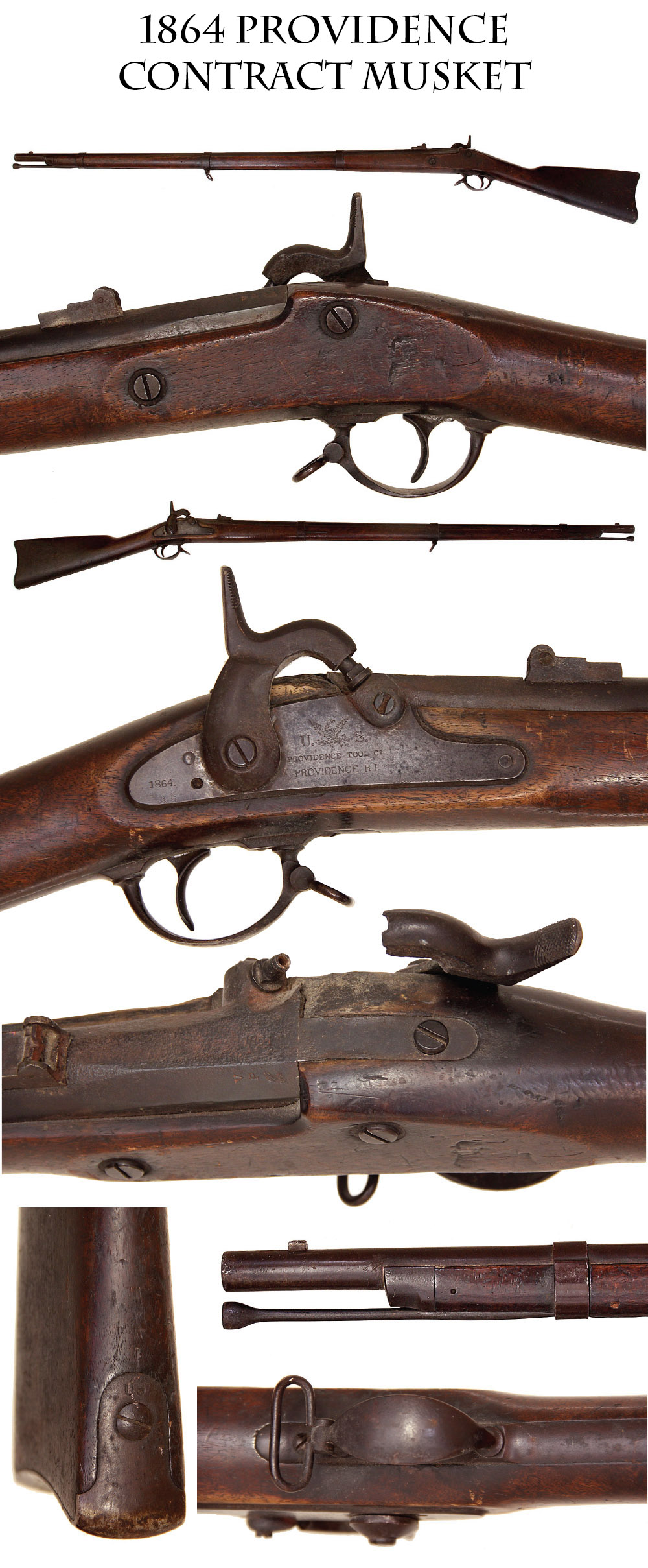
14-04-07 … Model 1861 Contract Springfield Musket by Providence Tool:
We tend to get fixated on national arsenal produced longarms, but government contractors put more of them in the hands of soldiers than did Springfield. Providence Tool Company in Rhode Island was one of the biggest producers: roughly 70,000 between 1862 and 1865. Like most of the other contractors, they were producing the 1861 pattern rifle musket. This is a very good attic condition gun as we like to find them. Dark patina overall but no damage from careless storage, just honest battle use showing a soldier valued it enough to purchase and bring home at the end of the war. Sights, bands, swivels in place, mechanism perfect. Very sharp lock markings, V/P/eagle proof on left barrel flat. Honest firing burns to the wood just aft of the nipple and light pitting to the breech next to it from the percussion caps. The matching 1864 barrel date is still visible. This is a gun that saw battle action. Only minor dings to the wood, light scratches and expected handling wear. A couple of dings opposite the lock on the flat. I don t see a cartouche, but they are frequently worn away on hard service guns. If you want an example of what great-great-grand-dad brought home and hung up in the parlor at the end of four years of fighting, this is it
… $1,250.00 SOLD
Click Here to E-mail Us!
Call us @ 419-842-1863

14-04-08 … Allen and Thurber Pepperbox Pistol:
A tribute to American mechanical invention. Before pistols with revolving cylinders carried the day these were the popular repeating firearms for frontiersmen, travelers, and Forty-Niners right up to 1865. They provided some extra firepower in dangerous circumstances and you certainly did not have to worry about a cylinder dropping out. Mark Twain recounted the difficulty of keeping your aim steady with these double action guns while the hammer raised and the barrel assembly rotated, but remarked if it did not hit what you were aiming at it would likely fetch something else. Good grip and legible floral engraving on the frame and nipple shield. Overall gray metal mixed with dark spots, but very good for one of these, which often show hard use and little care. Sharp Allen Thurber & Co. Worcester markings in the barrel flute, and very clear Allen s Patent 1845 markings on the bar hammer. Nipple shield has one corner missing next to the hammer on the top. Does not affect it mechanically and is hardly noticeable. Barrels are 3.5 inches long. A nice addition to a western or early pistol display. One of the truly affordable antique arms still available to the collector
… $495.00 SOLD
Click Here to E-mail Us!
Call us @ 419-842-1863

14-04-09 … Extra Fine Condition Ball Carbine:
The Ball carbine was another ingenious patent designed to use self-contained cartridges in a breech loading repeating mechanism. ;Like the Spencer, it used a magazine tube, but one placed under the barrel and loaded through an aperture in the receiver. It holds seven rounds in the magazine and one in the barrel. “E.G. Lamson” (of Lamson, Goodnow and Yale arms making fame) received the contract for 1,000 of these in June, 1864. Thus they qualify as Civil War arms even though a change in specified caliber from .44 to .50 and some manufacturing problems delayed delivery until after Lee’s surrender. Ours has extremely sharp wood, vivid purple and gray case colors on the receiver, very clear patent and manufacturer’s markings on the offside of the receiver next to the base of the sling bar. Rod, bands, sights in place. Barrel covered in plum brown faded blue. Very minor handling marks. Drawing back the hammer lets the triggerguard/lever lower to open the loading aperture. These would have made formidable weapons on the battlefield. A government test showed it could be loaded and emptied five times in under three minutes, that’s a lot of lead. Overall fine++ with two warts. There is a narrow band of wood filler where the right side of the stock-wrist meets the frame. (Behind hammer). Also one of the lock screws is damaged but still functions. Here is a top end Ball priced right
… $2,450.00
Click Here to E-mail Us!
Call us @ 419-842-1863
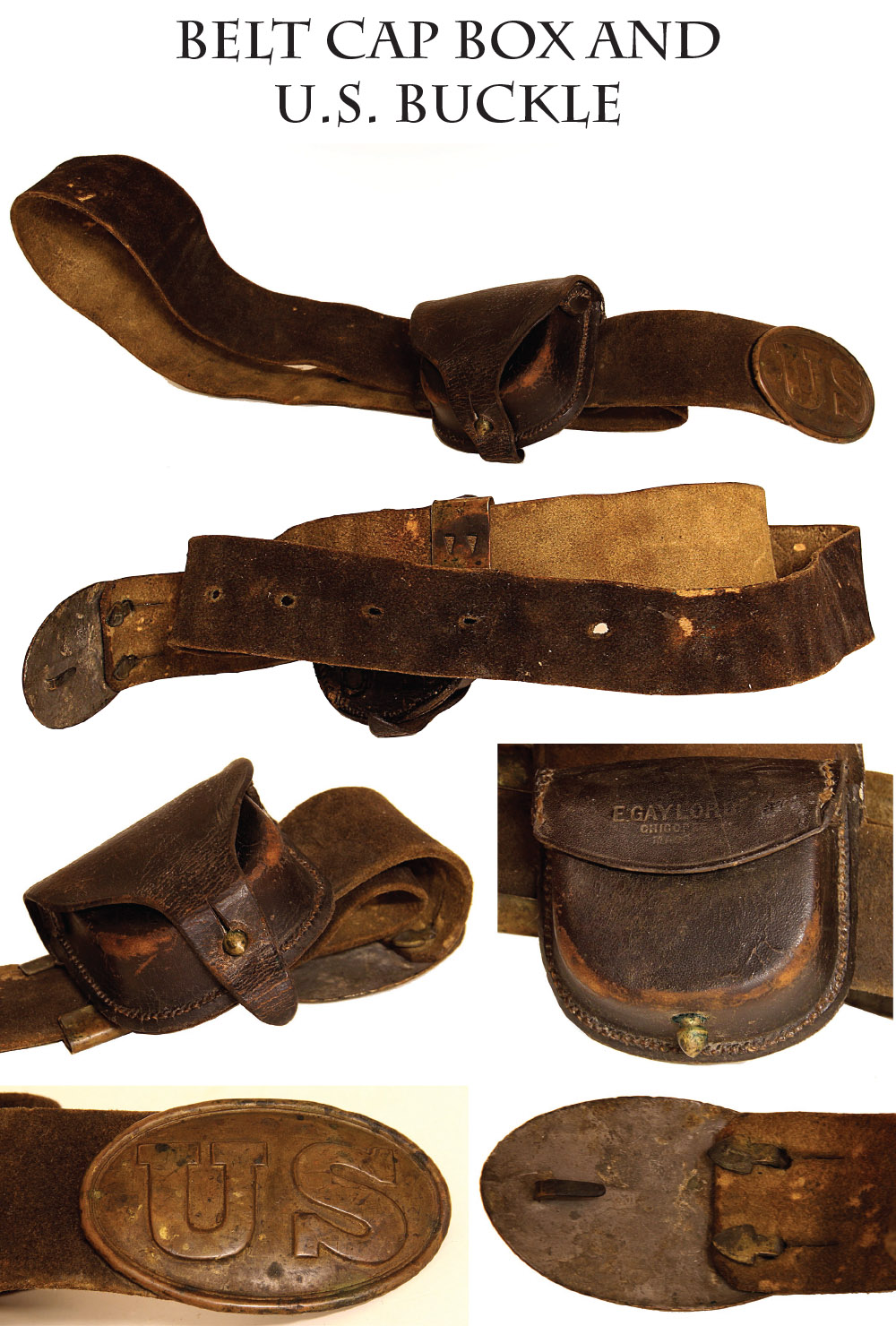
14-04-10 … US Civil War Infantry Belt Rig: Waist belt, US Plate, and Gaylord Cap Box:
This belt rig is just as you want to find them- obviously field used and brought home. The oval US plate has a nice mellow undisturbed patina, uncleaned and unmessed with. The belt is a nice deep brown buff leather. It retains the C-clasp brass keeper. The cap box is a very nice Gaylord maker marked example, no fleece or pick. Shows actual wartime use, some stains and some dirt — just like you expect from a “veteran”. Don’t dare clean this — it is superb as it is, and solid enough to display on a mannequin with a coat or jacket. Surplus belts are super for condition, but I still get a charge out of finding one issued, used, and untouched since 1865. A dandy!
… $550.00 SOLD
Click Here to E-mail Us!
Call us @ 419-842-1863
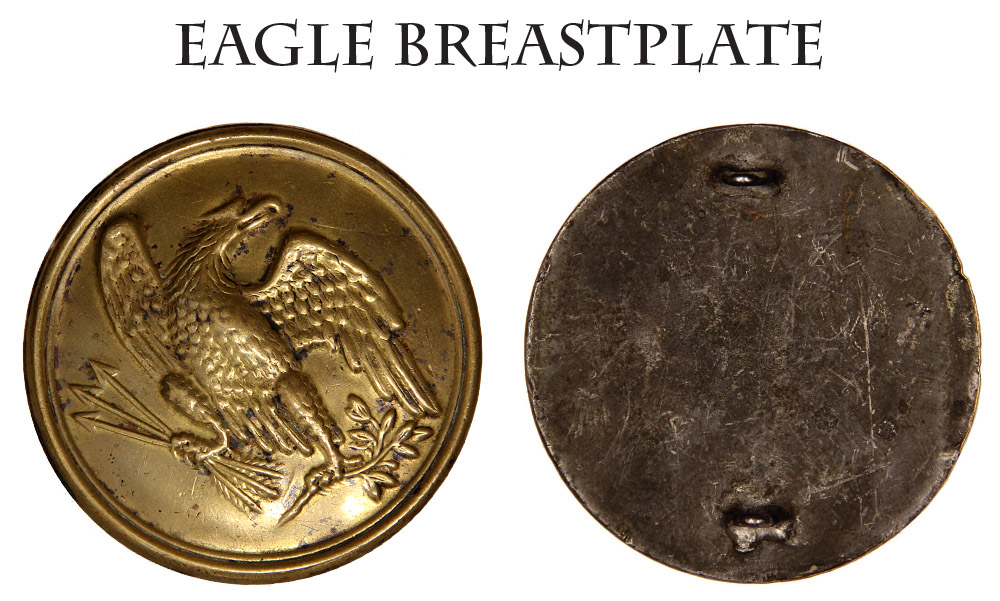
14-04-11 … Eagle Cartridge Box Belt Plate aka Eagle Breastplate:
Regulation Civil War circular eagle plate for the infantry cartridge box sling. Lots of original gilding. Two minor edge dings at 9 and 10 o clock. Both attaching loops intact. This pattern was introduced in the 1820s on the bayonet shoulder belts. Later they were transferred to the cartridge box slings when the bayonets were moved to the waist belt. They represented a bit of labor for the footsoldier, who was expected to keep them bright, along with his cartridge box plate and his waistbelt plate. They were very showy on parade and offered a convenient target in the field. A nice non-dug example
… $195.00 SOLD
Click Here to E-mail Us!
Call us @ 419-842-1863
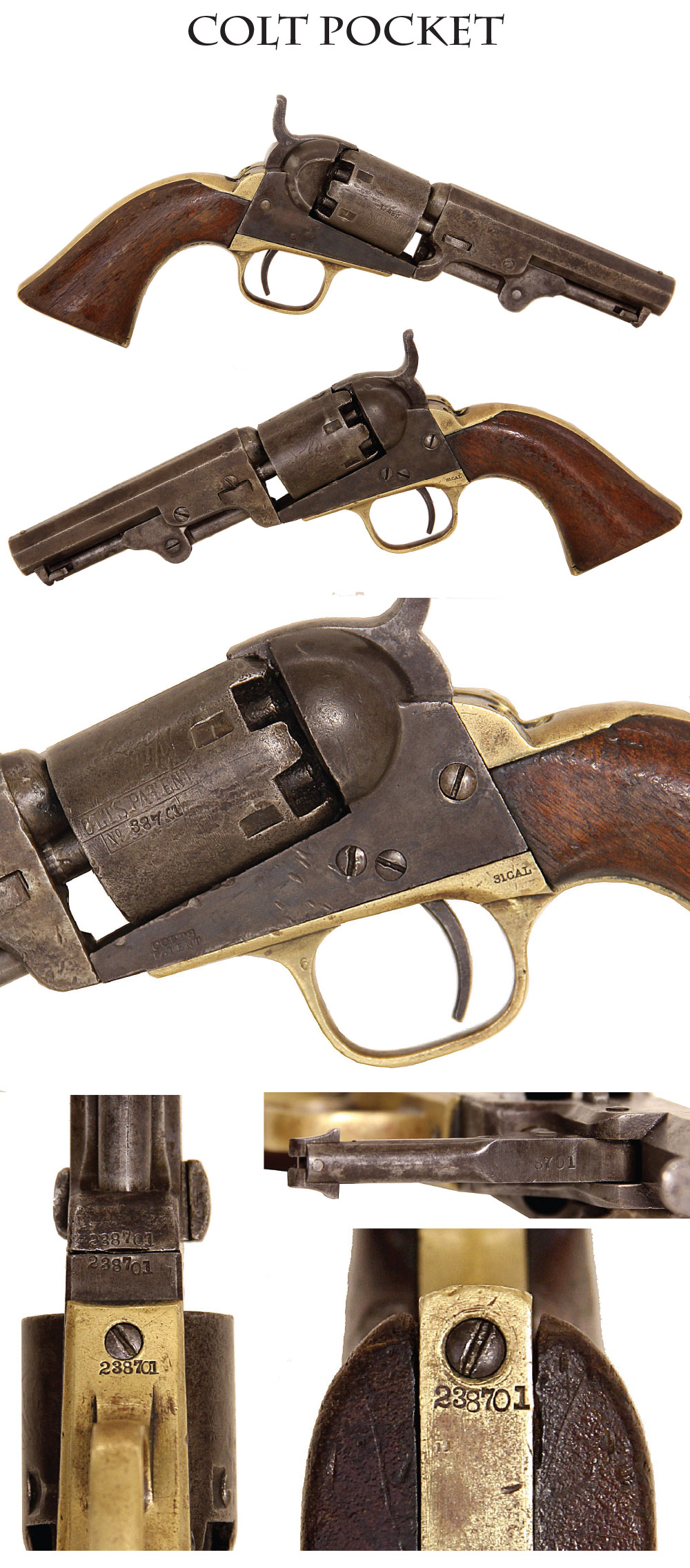
14-04-12 … Colt 1849 Pocket Revolver w/ 4 inch barrel:
The Colt pocket models embrace a large number of types and variations and are a collecting subgroup of their own. Made from 1850 through 1873, the gun chronicles the history of the country from the California gold rush into the western expansion after the Civil War. Ours is six shot and has matching serial numbers 238,701 on all the parts. Serial shows midwar production made in 1863. These were well regarded pocket pistols, carried off to war by thousands of volunteer soldiers and into the field by many officers who did not want a large frame revolver weighing them down on the march. Nice condition one piece walnut grips showing some of the original varnish, good wood to metal fit, just some shrinkage on the butt. Nice muted patina on the frame and rammer which show rumors of case color, screw slots show minor turning. Nipples crusty but not battered. Clear Colt patent and caliber markings. Traces of cylinder scene remain. Clear Colt marking and serial numbers. All original and mechanically perfect
… $650.00 SOLD
Click Here to E-mail Us!
Call us @ 419-842-1863

14-04-13 … 1861 Contract Rifle Musket With Springfield 1863 Lock:
Well used regulation infantry rifle musket that has been together for a long time, but at some point a Springfield 1863 dated lockplate replaced the contractor marked plate that was on the gun originally. Other markings and cartouches not visible though butt plate tang shows clear US. Needs a replacement ramrod. Bands, springs and swivels in place. Divot of wood out below nose cap, wear to rammer channel, slight crack on underside below entry for ramrod, another tight crack at the wrist, but the gun is stable. Sights in place, rear sight and nipple showing corrosion from use. Clean out screw head flattened. Lock screws nice, probably replaced along with hammer when the plate was added. Clear 1863, US Springfield and Eagle marks. Fore and aft short line cracks from the plate. Metal generally smooth, gray with some darkening, not pitted. Good butt stock. A presentable Civil War rifle musket that would look good in a display and not break the bank
… $850.00
Click Here to E-mail Us!
Call us @ 419-842-1863

14-04-14 … Very Rare French Officer s Saber for an Officer of National Volunteers under the Constitutional Monarchy of 1789-1792.
An extremely rare sword from the days of the French Revolution. Missing the elaborate guard that shows Athena and the triumph of the revolutionary ideology, but retaining the even scarcer original scabbard and worthy of restoration. Or if you need an original scabbard I dare say this is the only one on the market this year. Characteristic knights helmet pommel in place. Blade is bright mixed with gray and dark spots but showing very clearly the engraved martial motifs on both sides which retain most of their gilt fill. Good edge without nicks. Wire and some of the copper tape is present on the grip, wood is sturdy, but leather wrap should be redone. The scabbard is exceptionally rare: the leather is in very good condition, middle mount gone, but the drag and upper mount with carrying ring are present. This sword is a very scarce blade from the beginning of the French Revolution and the many wars and conflicts that followed, which threw Europe into turmoil. Swords with damaged or broken blades sometimes show up with good guards and this would be well worth acquiring to keep on hand to complete a restoration
… $1,250.00
Click Here to E-mail Us!
Call us @ 419-842-1863
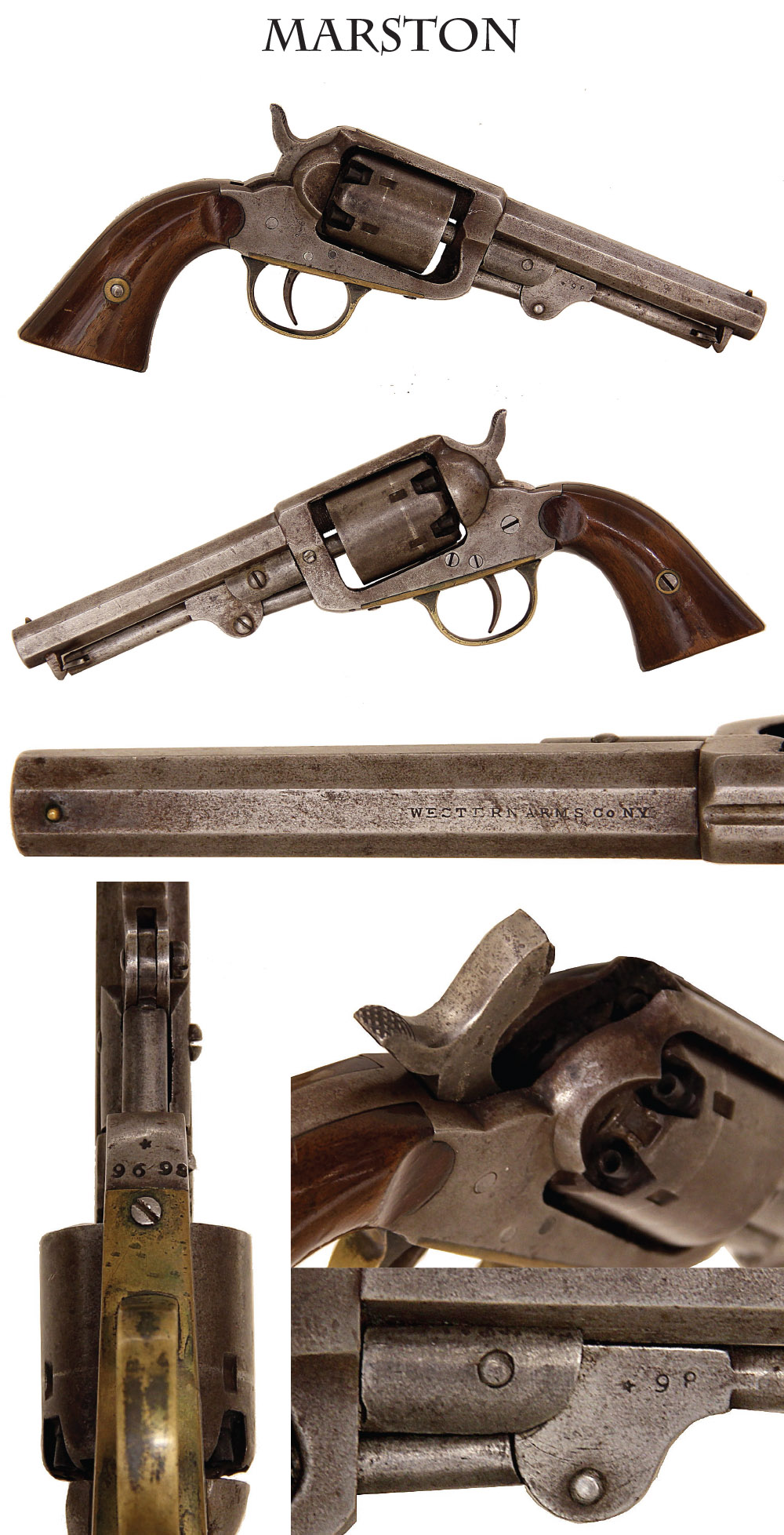
14-04-15 … Marston Western Arms
Nice Six-shot Marston Pocket Revolver with Western Arms Co. Trade Name as the barrel legend: Has 4.5 inch barrel. W.W. Marston made about 13,000 of these handy revolvers from 1858 into the early 1860s. Pocket revolvers became very popular during the Civil War and as the west opened up, but they were carried for personal defense also in the rougher environs of big cities like San Francisco in the 1850s. Many a Civil War recruit was furnished one by loved ones at home concerned for his safety. This is the Sixth type with the Western Arms co. NY barrel markings, serial number 9698, a six-shot cylinder and a top grooved frame. Super wood grips and smooth metal overall with a silver-gray patina and sharp markings, good mechanism. I have always liked early US pocket revolvers- tons of different styles and variations. Everyone was trying to be a Samuel Colt!
… $595.00 SOLD
Click Here to E-mail Us!
Call us @ 419-842-1863
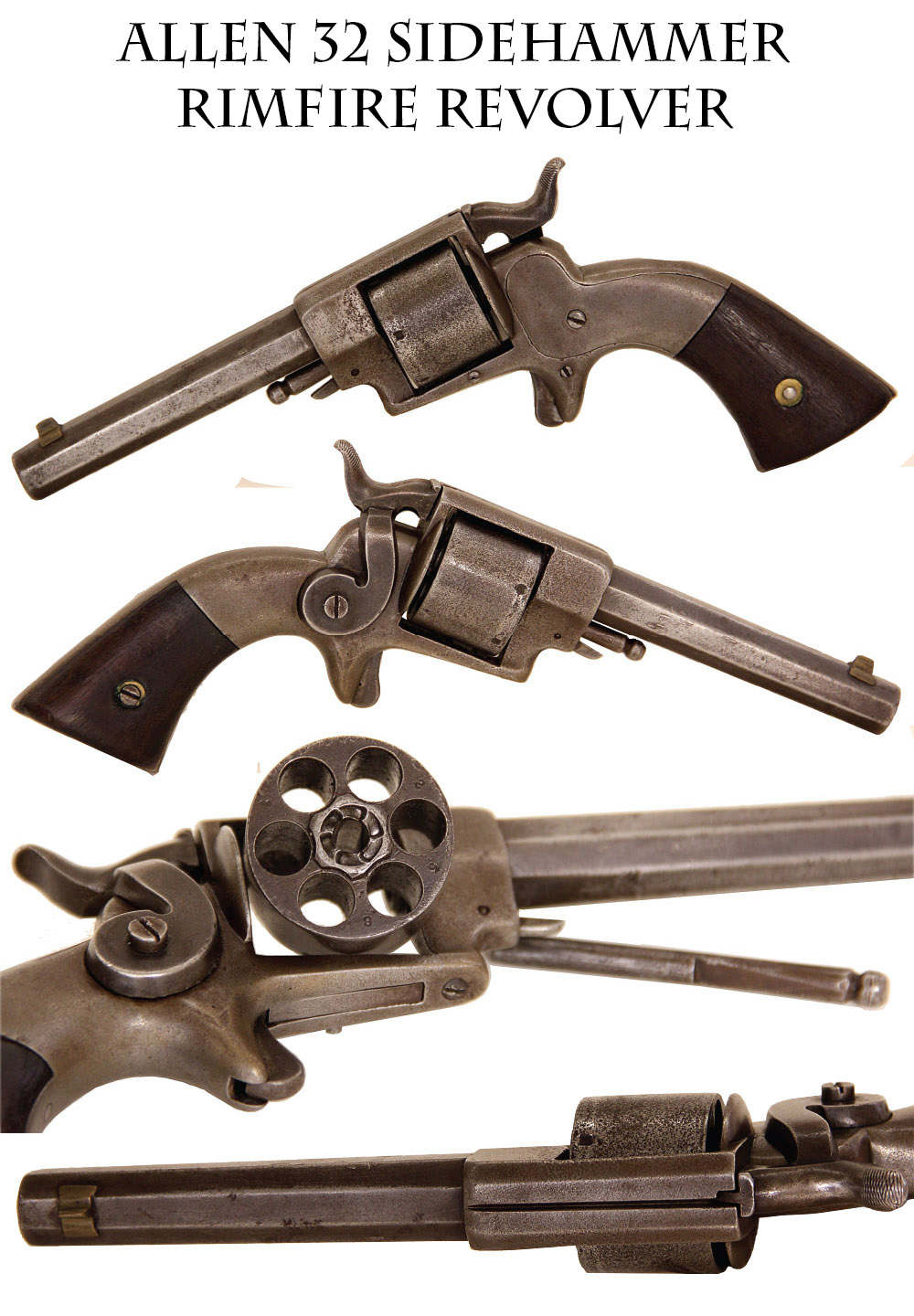
14-04-16 … Allen & Wheelock.32 Caliber Sidehammer Rimfire Revolver:
Six shot, 3.75″ barrel, totally unmarked: Made between 1859 and 1862. These fit in with my interest in the smaller pocket pistols that were far more widely carried during the period than the large frame revolvers. This pistol has nice wood and smooth grey metal. Light salt and peppering overall on the cylinder and cylinder arbor. Front entry cylinder pin, grooved top strap, projecting button. I see no cylinder scene or markings at all except a cylinder number, but these guns were usually batch numbered rather than serial numbered. A nice little Civil War period pocket revolver. Flayderman # 5a 072
… $395.00 SOLD
Click Here to E-mail Us!
Call us @ 419-842-1863

14-04-17 … Pennsylvania Soldier’s Musket:
Leman Alteration of 1816 Pattern Springfield done for Pennsylvania in 1861. Pennsylvania contracted with Henry Leman in Lancaster, PA, to alter the states flintlock arms to percussion on June 28, 1861. Leman altered over 11,000 guns in 1861, and a total of 17,547 by 1863. He used the chambered breech method with a cleanout screw as seen here. The cone in barrel method was deemed unsafe and although some percussion muskets were also rifled and sighted there was concern this would weaken the barrel and he did few of those. This is an 1834 dated Springfield 1816 pattern. The butt plate shows some corrosion from resting on a floor, the wood is overall very good, just a slight straight line running back from the rear point of the lockplate. The metal is overall smooth, light gray with dark gray areas, with brownish bands and hammer. Some corrosion and crustiness to the hammer tip, bolster, breech and upper lock edge from firing. Lockplate mottled grey and very legibly marked, Springfield 1834 to rear of hammer with eagle and US forward of hammer. Wood has two very evident cartouches on the offside. Sight, bands, rod, swivels, etc. all in place. Mechanically very good. A very typical early war arm and one that undoubtedly saw action. Pennsylvania sent a large contingent of troops off to war and when they exceeded their quotas, the state organized the Pennsylvania Volunteer Reserve Corps to retain the men in service. There is a small “x” carved on the underside of the stock near the triggerguard tang and a nicely done set of initials, “J Z T” on the offside of the butt and a small stamped name on the other side: “L. Tisdel.” It is no big leap of logic to suppose the carved initials represent a J.Z. Tisdel. In any case, I can’t pin this name to a soldier in the databases… but variations in spelling may be the explanation. Undoubtedly some genealogical sleuthing can be done to solve the mystery. I like it as an early war musket
… $795.00 SOLD
Click Here to E-mail Us!
Call us @ 419-842-1863
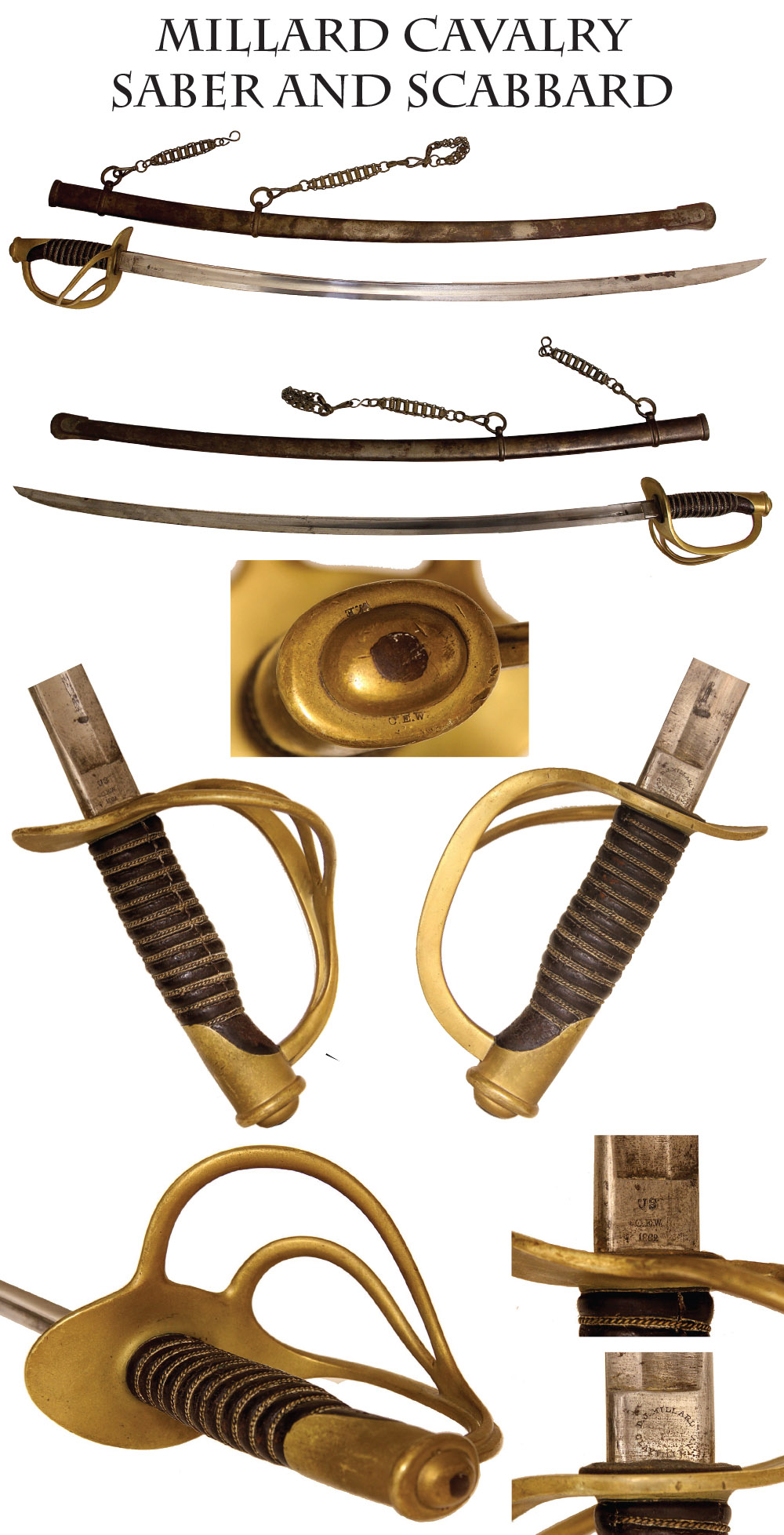
14-04-18 … Millard Cavalry Saber …
New York Trooper’s Dated and Inspected 1862 Light Cavalry Saber by Millard. Millards have always been sought after, being one of the smallest contracts. This is a nice one with bright blade and some minor scattered dark spots and graying on the top outboard side about six inches from the tip. Very clear Millard, Clayville, NY, maker marks, inspector initials and date at the ricasso, matching C.E.W. inspector marks on the pommel. Good scabbard, no dents, just some age darkening, very good grip with original leather and wire. Still has chain hangers attached to the carrying rings that were on it when it came out of the Mott-Morse estate auction in New York last winter. Fresh to the collector market. A nice example of a scarce and desirable 1860 light cavalry saber by a sought after maker
… $1,295.00
Click Here to E-mail Us!
Call us @ 419-842-1863

14-04-19 … Intriguing 1835-40 Conversion Musket:
One of the guns used to arm volunteers both US and CS in the early days of the Civil War. This one is VERY interesting as it incorporates a Model 1835 musket but utilizes a converted Model 1816 musket barrel with loads of proof and inspection marks at the breech. This utilizes the regulation “cone in barrel” conversion performed at the national armories and elsewhere. In this case, the barrel shows very clear V, P, and eagle proofs and a date on the breechplug tang of 1827. Has 1841 dated Springfield lock. All stampings very clear and sharp. Visible ink cartouches on the offside flat, some smaller numbers and letters on the barrel near the breech, probably a company letter and rack number. “WH” and a numeral lightly scratched on the inboard side of butt. No pitting to the barrel, smooth metal with some bright showing through and surface age browning on the top. Same pleasing patina on the hammer and lockplate. Minor handling marks and one or two old small dimples or divots in the wood. Original rod, bands, springs, swivels, etc all in place. One small crack on shoulder of one band, but stable. Sharp nipple. A nice conversion musket and most intriguing with the mixed model parts.
xggjx
.
… $995.00 SOLD
Click Here to E-mail Us!
Call us @ 419-842-1863
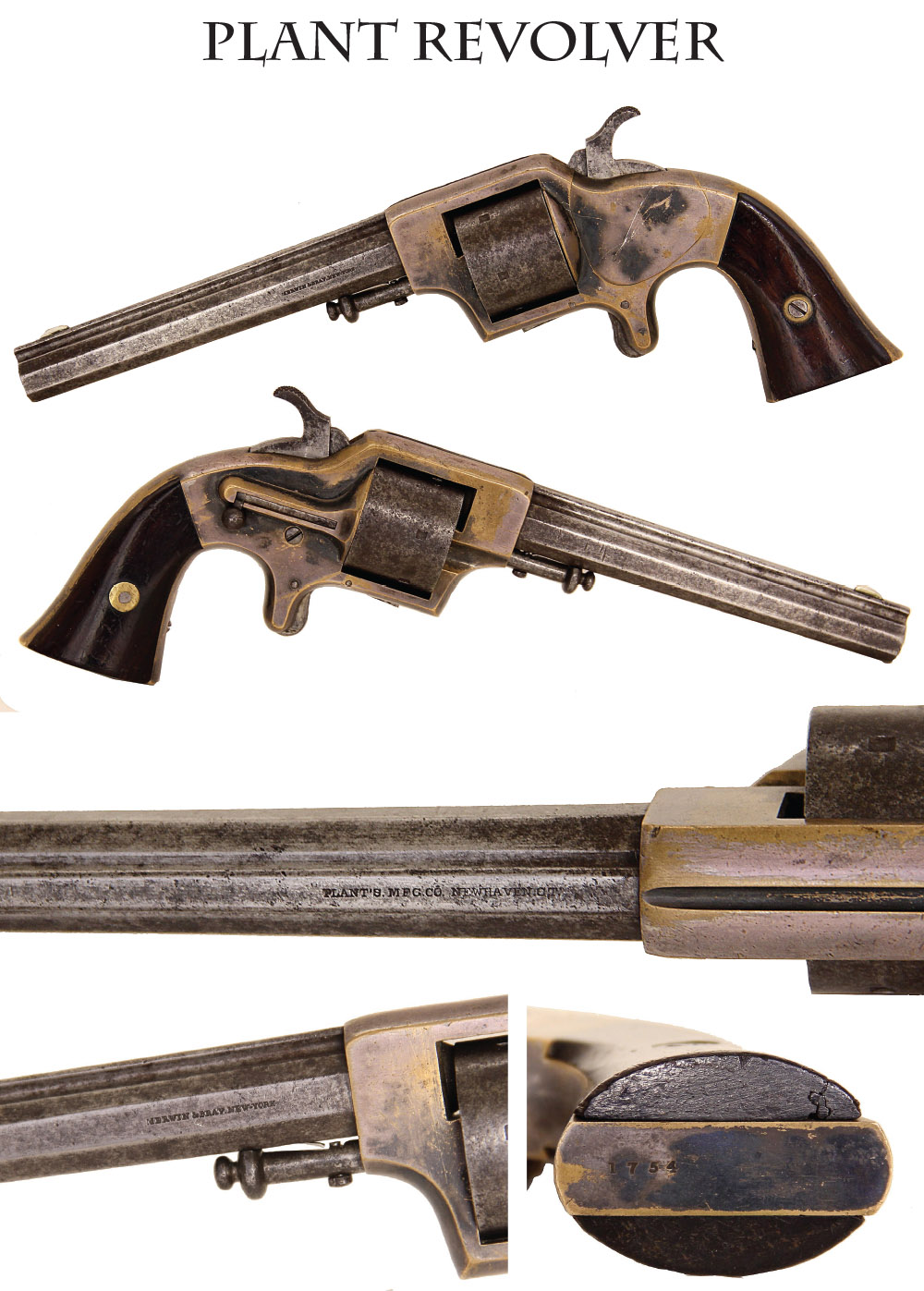
14-04-20 … Plant “Front-Loading” Army Revolver:
Serial number 1754, third model. Six inch barrel, six shot. These .42 caliber revolvers were another popular privately purchased handgun in the Civil War. They fired a cup primed cartridge that was loaded from the front of the cylinder, and were sometimes provided with a standard percussion cylinder as well. Nice clear Plant markings on the barrel and Merwin & Bray New York barrel markings as is correct (they backed Plant and acted as agents.) The revolver is an interesting invention in that some of the design was an attempt to bypass patents held by Smith and Wesson. Very nice wood grips, barrel gray with dark spots, but no pitting and clear marks. Cylinder shows salt and peppering. The brass frame still shows a lot of silver plating, some of which has turned black in places, giving it a mottled appearance but this could be lightened with some careful cleaning.
zfjjx
… $795.00
Click Here to E-mail Us!
Call us @ 419-842-1863

14-04-21 … Hawksley Signed “Fire Proof” Powder Flask:
This rifle size flask has some nice colors: the copper body preserves most of its original lacquer finish and the spring on the brass throat shows most of its original blue. Nice mellow tone to the brass. Thumbpiece with concentric circles, spout adjustable is measurement by drams. A couple of depressions from use on the body as might be expected. Very nice overall. Maker marked: “C&J W. H.” on the top, along with the assurance “Fire-Proof,” which is a good thing to know when you are firing guns near a pint or so of black powder.7.5 inches overall length including including the spout
… $225.00 SOLD
Click Here to E-mail Us!
Call us @ 419-842-1863

14-04-22 … Regulation Civil War U.S. Officer’s Eagle Hat Insignia:
Very nice large example (3 inches tall) of the regulation insignia used by officers to loop up the side of their dress hat. Enlistedmen were issued the government stamped brass version. Officers purchased the higher grade embroidered style. This one has the metal back behind the velvet face for sturdiness. Cloth backing is still in place, the backing fabric has shifted slightly here and there, which is usual. One attaching loop is present, the other is long gone. Velvet face preserves most of its original black, just some slight oxidation to brown at the edges. Extremely nice gilt embroidered eagle with red eye and sequined wings set off with silver stars, etc. Jaceron wire border in place. These are not easy to find anymore… It turns out they really are rare and antique. Perfect for an officer’s uniform or insignia display. I wish I had more
… $550.00 SOLD
Click Here to E-mail Us!
Call us @ 419-842-1863

14-04-23 … Soldier s I-XL Bowie Knife- Kept in use for for fifty+ years …
No matter what, it is tough to find these knives with their matching scabbards. Nice large size … Overall length is 10 inches. Blade length 6 inches. This one retains its bluish-green leatherette scabbard with gilt stamped edge on both sides and the I*XL motif on one. It retains both German silver throat and tip. The button on the throat is gone. Bone slab grips fastened with four pins, an inset German silver lozenge in the center of one side. Double edge spear point blade showing graying and dark spots but no edge nicks or grinding. Nicely marked on one side of the ricasso: I*XL/ George/ Wolstenholm/ Celebrated / Cutlery and on the other a horse. German silver guard. The extra cool thing about this knife is the dead real 1863 date scratched on the reverse slab and both 1863 and 1912 scratched on the obverse bottom and top. The 1912 date seems put in by a frailer hand. The likely scenario is that the soldier purchased this in 1863, or was given it then, carried it home, and as the fiftieth anniversary of his service approached commemorated it by scratching the 1912 date in the handle to match the date he got it. It is also possible he gifted it to a grandson serving in the army who in turn dated it. I love this thing. It would make a nice part of a display of soldier s personal effects since so many photos show men with these stuck in their belts, but there are very few real pieces with actual soldier inscribed dates on them
… $795.00 SOLD
Click Here to E-mail Us!
Call us @ 419-842-1863
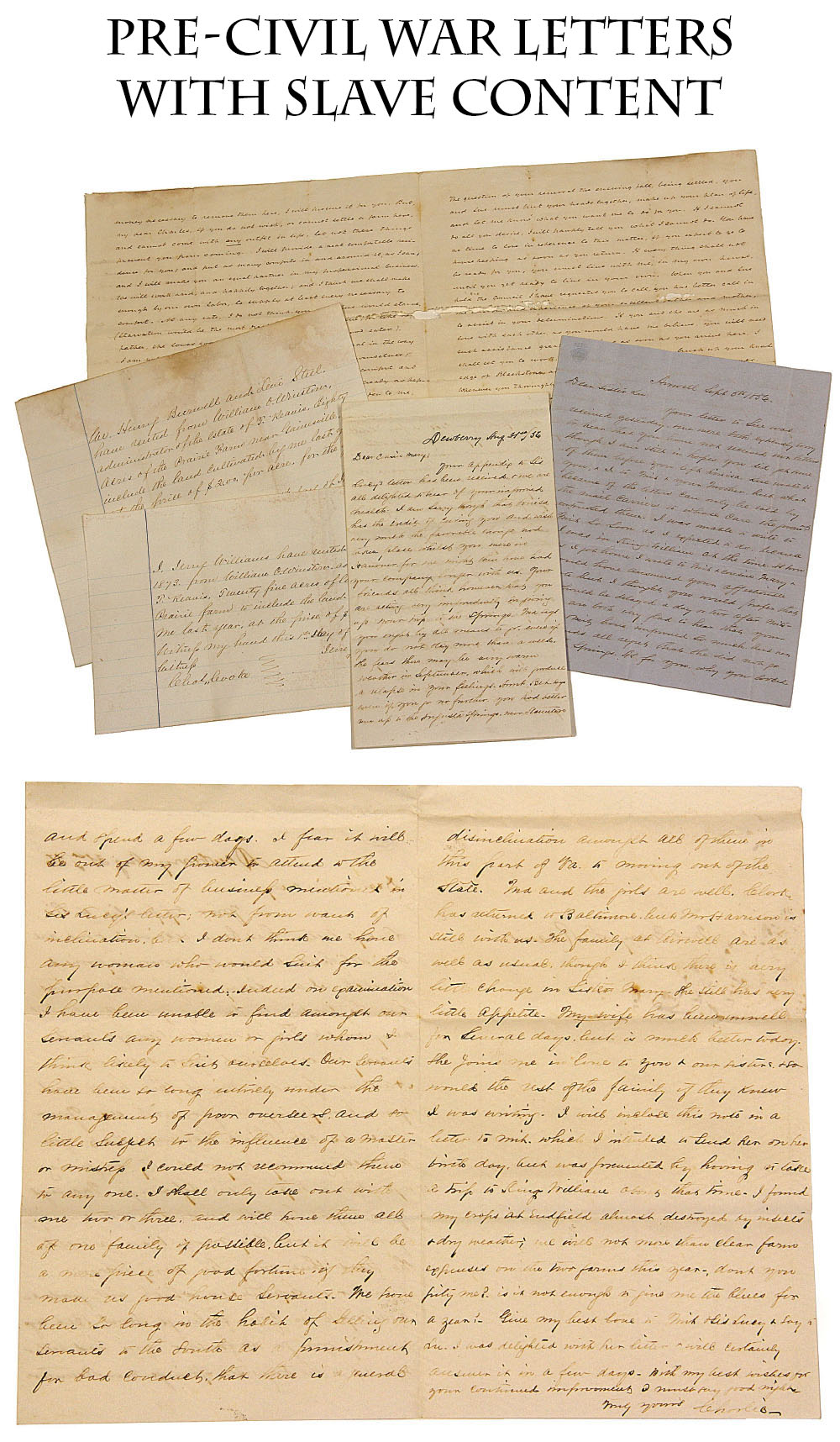
14-04-24 … Southern Letters w/ Slave Content.
Three pre war four page letters circa 1856 and two 1870s receipts. All three pre war letters are interesting with news from Virginia and Alabama. The cream of the lot is a letter dated Dewberry Aug. 31st 1856 from Charles Cook to his cousin. It starts out with family news and then includes the following unabashed commentary … “… I fear it will be out of my power to attend to the little matter of business mentioned in Sis’ Lucy’s letter, not from want of inclination but I don’t think we have any woman who would suit for the purpose mentioned. Indeed, on examination, I have been unable to find amongst our servants any women or girls whom I think likely to suit ourselves. Our servants have been so long entirely under the management of poor overseers and so little subject to the influence of a master or mistress, I could not recommend them to anyone. I shall only take out with me two or three and will have them all of one family if possible, but it will be a mere piece of good fortune if they make us good house servants. We have been so long in the habit of selling our servants in the South as punishment for bad conduct that there is a general disinclination amongst all of them in this part of Va. to moving out of the state…” I believe that section of that one letter is worth triple the price of admission to this lot. One hell of a piece of manuscript slave history from the Southern point of view. For the lot
… $595.00
Click Here to E-mail Us!
Call us @ 419-842-1863

14-04-25 … Battle Damaged European Import Musket – Wasn t He Surprised!
One of the coolest relics I have owned, and I ve kept this one several years in my personal relic display. This musket had a story to tell and is undoubtedly an early battlefield pick-up. Sadly the specific history has been lost to time. The jarring, visual, story it imparts allows for some wonderful mental conjuring. This is a typical early war European import musket – a French 1842 pattern infantry musket- one of many types both sides brought in to arm the early war regiments. Something happened – and it was dramatic. The barrel is bent upwards from a severe impact on the top somewhere around the middle band. The force of the blow forced the fore part of the barrel upward and sent longitudinal cracks through the stock all the way back to the trigger guard. This is much more than a bullet strike or being driven over by a wagon. The force to cause this damage had to have been explosive. I would expect to see such a relic at the Petersburg Mine explosion. Whatever caused it, it was enough of a telling battle relic for someone to retrieve it and preserve it in its damaged state. Just like war logs, but much rarer, battle damaged guns are a visible reminder of how dangerous it was on the battlefield: if gun powder, flying iron, and lead could do this to wood and metal imagine what it could do to flesh and bone. The nipple is not battered down indicating the gun was in use at the time of being damaged. All the swivels, bands, etc. are present. The rear sight base is present, the leaf is long gone. Butt plate and bands show pitting, the wood is very good and still shows some of the original arsenal marks. No need to go on about how this would look in a display- it is a display in and of itself
… $1,800.00
Click Here to E-mail Us!
Call us @ 419-842-1863

14-04-26 … War of 1812 / Battle of Waterloo Era Unit Marked Ramsey and Sutherland British Yeomanry Militia Musket and Bayonet:
Under threat of invasion by the French in the 1790s the British formed a number of volunteer militia units titled Yeomanry. Like their American counterparts, they often carried commercial versions of standard army issue weapons. This is a commercial pattern of the Third Model Brown Bess with a Ramsey and Sutherland, London signed lock … rounded side plate, barrel with nice visible proofs at breech, complete with sling swivels, rod, etc. This remains in original flintlock ignition, and still retains its long flat-bladed “volunteer” socket bayonet. The buttplate tang shows period markings “ Y M/ N. 9 / B” The “M” is likely a local designation such as “Middlesex,” and the markings below indicate it was the ninth weapon in Company B. Wood has good color and honestly worn. A horizontal repair line clearly shows on the butt stock below the handrail. The butt was apparently repaired long ago as the two grains of wood are different. Minor rounding from handling, still a prominent apron at the breech, minor line forward of the lock plate. Smooth metal showing lots of faded patina in smoky mixes of gray … untouched patina to the brass. This is a good looking flintlock musket and impressive with the bayonet fixed. 39 inch barrel. Roughly 70 caliber and a wonderful value for a 200 year old musket
… $975.00 SOLD
Click Here to E-mail Us!
Call us @ 419-842-1863
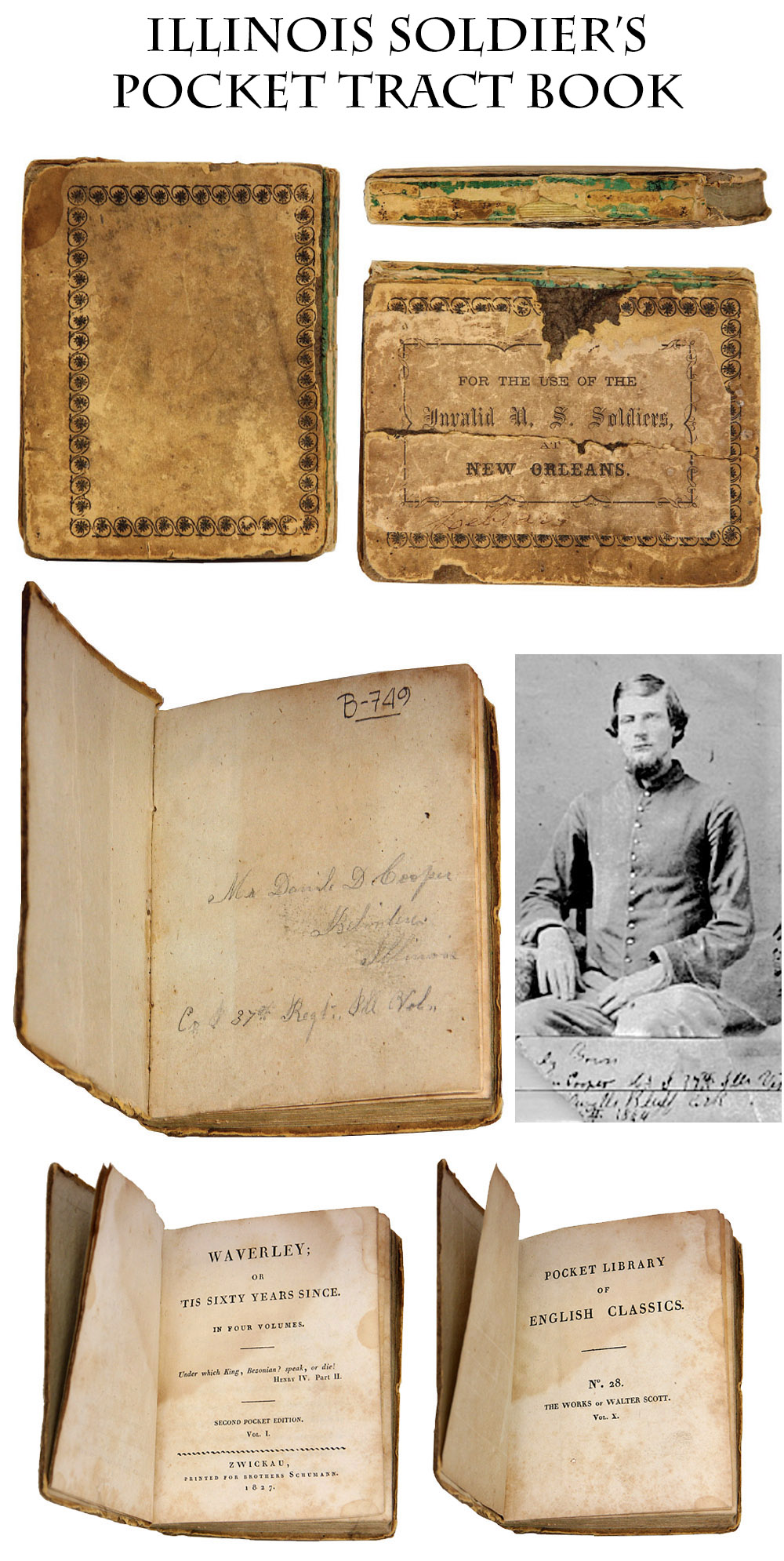
14-04-27 … US Hospital Library Marked – 37th Illinois Identified Tract Book:
1827 dated volume of Sir Walter Scott’s “Waverly or Tis Sixty Years Since” (one of four volumes that comprised that work), part of the “Pocket Library of English Classics.” Pasted to the cover is a printed paper label reading “For the use of invalid U.S. Soldiers, at New Orleans,” with the handwritten addition in ink “library.” Given the publication date, this could have been a charitable donation to a Mexican War era military hospital in that city, but is more likely a Civil War contribution to the hospital service. This is backed up by the period pencil identification on the flyleaf reading:
“Mr. Daniel D. Cooper / Belvidere/ Illinois / Co I 37th Regt. Ill Vol.” Cooper is listed in CWData as a resident of Belvidere who enlisted at age 24 on 9/1/61 as a private and mustered into Co. I 37th Illinois on 9/18/61. He re-enlisted as a veteran on 2/10/64 and was wounded severely in the left arm at Fort Blakely, Alabama, on April 9, 1865. This resulted in the amputation of his arm and his discharge for wounds on 5/24/65. He died in 1897 and was buried in Garden Prairie, Illinois. Note the photo of him found on the internet. I wonder if he was blinded in one eye as well? The 37th is a very interesting unit and there is far too much recorded in their history to more than summarize here. The unit was nicknamed the “Fremont Rifles” and saw very active service in Missouri, Tennessee, Mississippi, Louisiana, Arkansas and later Texas (after Cooper’s wounding.) Under Fremont it took part in the capture of Springfield, Mo., and then served under Curtis and Herron, being part of the Army of the Frontier, Department of the Tennessee, the Army and Department of the Gulf, and the 13th and 19th Corps at different points. They took part in major engagements such as Pea Ridge and Prairie Grove, and were involved in the siege of Vicksburg, but also took part in numerous skirmishes and expeditions against Confederate guerrillas in Missouri and raiding forces elsewhere, earning the second nickname of the “Illinois Greyhounds” for their numerous and rapid marches. By the end of their service they had covered more than 3,000 miles on foot and another 14,000 by ship and rail. They lost 4 officers and 60 enlistedmen killed in action or mortally wounded.
The book is in somewhat delicate condition, with some tears and separations, but it displays very well and is a good candidate for a medical display but also for someone interested in the 37th Illinois and the western campaigns. It is also a reminder that the war did not end with Appomattox and a telling memento of a soldier who almost made it through unscathed, but suffered a crippling wound the same day Gen. Lee was surrendering
… $235.00
Click Here to E-mail Us!
Call us @ 419-842-1863
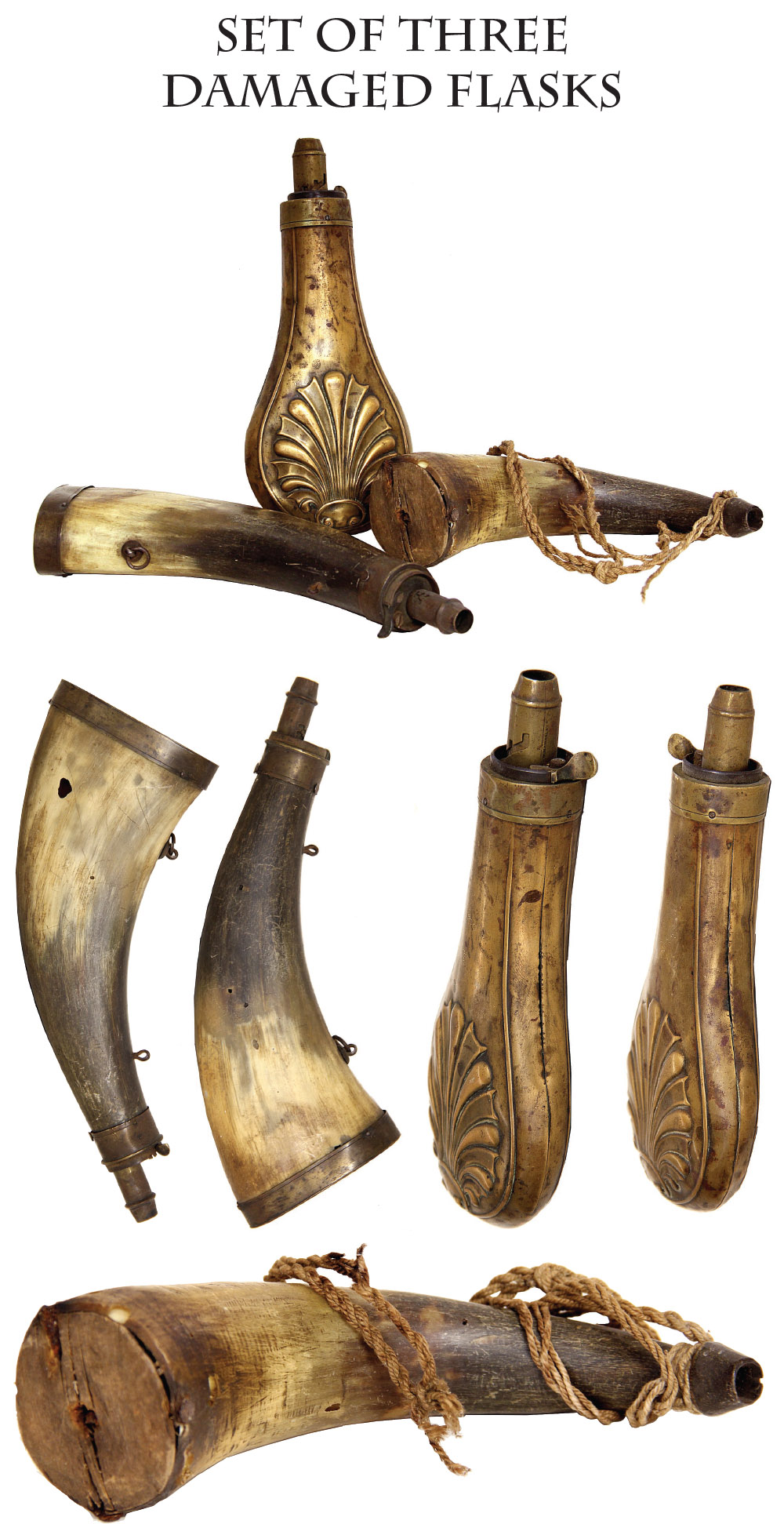
14-04-28 … Set of 3 damaged flasks …
These would be great for a display of real, worn used flasks. In better shape, each of these would command more than what we’re asking for all three
… $75.00
SOLD
Click Here to E-mail Us!
Call us @ 419-842-1863
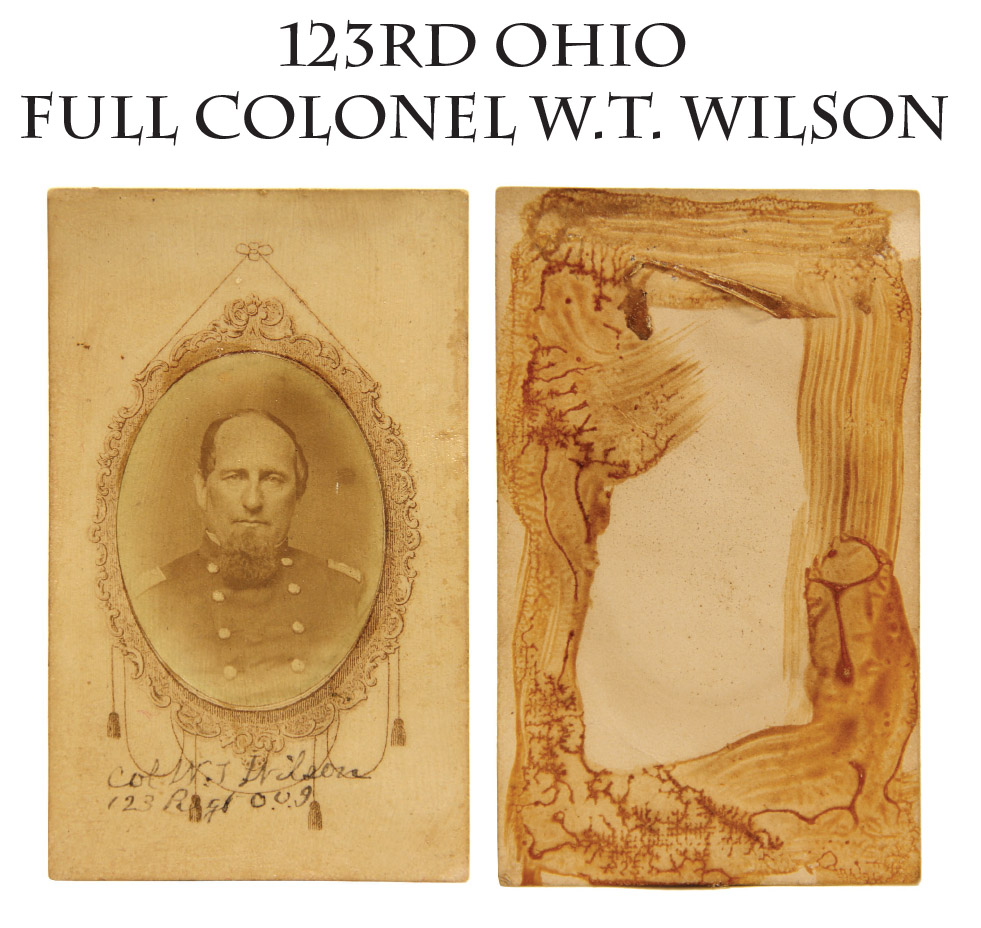
14-04-29 … Rare Subject ; Brevet Brigadier General William Tecumseh Wilson 15th and 123rd Ohio Infantry:
Vignetted oval bust view in a field-grade officer s coat mounted on a cdv card with a printed hanging frame to mimic a portrait hung on a wall. Tones a tad light, but clear. Reverse shows glue marks from mounting in an album. Old ink identification bottom front: Col. W. T. Wilson / 123 Regt O.V.I. Wilson is a tough Ohio colonel and brigadier general to find in an original 1860s photo. Born in 1823 in Pennsylvania, he apprenticed as a printer and eventually rose to be newspaper publisher and editor. During the Mexican War in enlisted in the Pennsylvania volunteers and participated in the sieges at Vera Cruz and Puebla, and the capture of Mexico City, rocketing up to the rank of fourth corporal by the time of his discharge in 1848. Thereafter he published newspapers in Hollidaysburgh, Pennsylvania, and then in Blair County, Ohio. When war broke out, he enlisted at age 35 on 4/23/61 and was commissioned Captain of Co. C 15th Ohio Volunteer Militia on 4/27/61. This was one of the first Ohio regiments, enrolled for three-month s service, and was sent to West Virginia. There they did guard duty, but also served on a number of expeditions and took part in the actions at Philippi, Laurel Hill and Carrick s Ford. After the regiment was mustered out, Wilson was promoted on 8/6/61 to Lt. Colonel of the 15th Ohio Volunteers, a three-year outfit assigned to the Army of the Ohio, which first saw action at Shiloh in April, 1862, losing 6 killed and 62 wounded under command of the regiment s major. Wilson must have been well regarded, however, he was discharged from the 15th OVI on 9/26/62 for promotion to Colonel of the 123rd Ohio on 9/26/62, which again placed him in western Virginia. The regiment s first real action was during Lee s advance north in the Gettysburg campaign when they fought General Early at Winchester, losing some 100 men before being compelled to surrender the next day, 6/15/63, with the rest of the brigade. Wilson was confined at Macon and at Columbia, before being paroled 3/18/64 and officially exchanged 5/28/64. The regiment saw more action at Lynchburg, Snicker s Ferry, Winchester, Berryville and other locations, facing off against Early several more times. Only at Opequon, Fisher s Hill and Cedar Creek did they begin to taste victory and thereafter went to Bermuda Hundred and the siege of Petersburg, where they eventually gained credit for capturing two enemy flags. It was irony that their last action was the Battle of High Bridge in the pursuit of Lee, where they were hit from the rear by Confederate cavalry and once again became prisoners of war. Wilson mustered out with the regiment on 6/12/65. During their service they had suffered heavily, losing 91 officers and men killed or mortally wounded. Wilson served as Comptroller of the Treasury in Ohio and also as mayor of Upper Sandusky. He died at Columbus, Ohio, in 1905. Extremely scarce subject
… $250.00
Click Here to E-mail Us!
Call us @ 419-842-1863

14-04-30 … Likely an Ohio Infantry Line Officer:
A nice CDV of an infantry line officer with some character. Typical of the young men who led companies into battle. This officer wears a plumed slouch hat with an embroidered infantry officer s hunting horn on the front and holds his foot officer s sword in its scabbard to the front with his hands on the pommel at parade rest. His frock coat is single breasted, showing him to be a captain or lieutenant. I think I see a single bar on the forward part of his shoulder strap, which would make him First Lieutenant. In any case, he was one of the line officers who mixed with their men on a daily basis and led them on the firing line. He was proud of his officer s sword, to show it off to the camera he had to unhook it from its sword slings, which hang from his officer s waistbelt. Part of his belt plate shows above his clasped hands, and his officer s sash hangs down, the tassels showing at the left knee of his light colored trousers. This is a studio shot with a plain backdrop, but the rug shows a pattern. I can t help noticing that rather than a fancy pair of boots he has adopted a comfortable pair of shoes for the long marches trudging beside his men. No backmark, When I was a teenager I found a CDV album here in NW Ohio that contained another identical CDV to the one here shown. As I recall that one bore a poem… “Remember me when this you see Though a thousand miles between us be.” I don’t know who this man is but I’ll bet he served from Ohio or Michigan. Neat view
… $95.00
Click Here to E-mail Us!
Call us @ 419-842-1863

14-04-31 … Special Aide to Lincoln / African American Related / Signed CDV of Colonel Le Grand Bouton Cannon, Aide-de-Camp to General Wool, influential in the Union Defense Committee in 1861,
the sheltering of escaped slaves at Fortress Monroe, the enlisting of black troops in the army, and internal army politics. Crisp vignetted bust view of a field-grade officer with flashy sideburns! Cannon was from New York and had served as a volunteer on General Wool’s staff before the Civil War. When most of Wool’s staff resigned and went south, Cannon and a few other prominent New Yorkers joined his staff as volunteers, Cannon acting a volunteer ADC to Wool from April 23 to August 28, 1861. During this period he took an active part in the Union Defense Committee of New York in corresponding with and aiding various northern governors, like the Governor of Illinois, who were trying to obtain arms, etc., and organize without adequate leadership from Washington.
Cannon was officially appointed Major and AADC on Wool’s staff August 28; and Colonel on Feb. 1, 1862. He accompanied Wool to Fortress Monroe, Virginia, which they preserved for the Union. Cannon was involved in formulating the “contraband” policy about escaped slaves who had sought protection at Fortress Monroe and was intimately involved in some of the army’s political infighting. His reminiscences published after the war include a number of first hand accounts of the Monitor and the Merrimac, time spent as a special aide to Lincoln, and experiences with Secretary Stanton, etc. Cannon resigned June 11, 1862, but rejoined Wool’s staff as a volunteer for a time thereafter, until Wool’s retirement in 1863. Cannon’s accounts are a real insider’s view of the doings at various army headquarters. He had been offered the military command of Norfolk, before resigning.
The card is presented to Lt. Col. Whipple, who is probably William Dennison Whipple, West Point class of 1847, who served until 1890, was both ADC and AAG at different points in his career, served on Gen. Hunter’s staff, the staff of General Thomas, and after the war as ADC to Sherman from 1873 to 1878: “Lt. Col. Whipple USA / Asst Adjt Genl / With regards / Le GB Cannon Col / USA & ADC.” Their staff duties had probably brought them into connection at some point, though Whipple was a New Yorker like Cannon.
A significant subject involved in some important early war doings
… $225.00
Click Here to E-mail Us!
Call us @ 419-842-1863
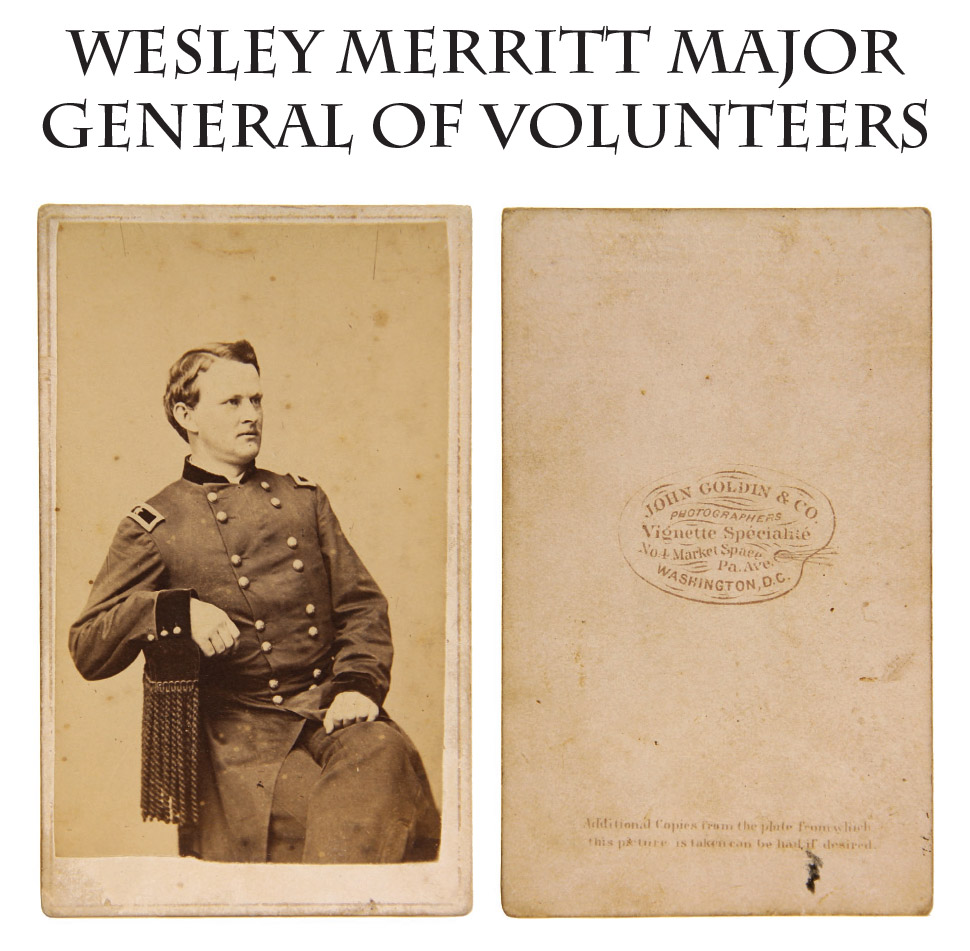
14-04-32 … Wesley Merritt as Brigadier General –
from Gettysburg to Appomattox, the consummate cavalry commander. Jumping several ranks, Merritt was promoted from Captain to Brigadier General along with George Armstrong Custer on June 29, 1863, but showed better sense than the latter in not leading his command to massacre in the post war campaigns against Indians. Merritt was West Point class of 1860 and served briefly in the dragoons before being called to serve as aide-de-camp to both Generals Cooke and Stoneman who commanded the cavalry of the Army of the Potomac. Following his promotion to Brigadier General he commanded one of Buford s brigades in the Gettysburg campaign and a division soon after, serving as second in command to Phil Sheridan by war s end. He was brevetted several times and made Major General of Volunteers before reverting to Lt. Col. of the 9th Cavalry after the war, Colonel of the 5th in 1876, and eventually brigadier and major general in the regular army. At the outbreak of the Spanish-American War he was the commander of the expedition to the Philippines and cooperated with Admiral Dewey in the capture of Manila. He retired from the army in 1900 and died in 1910. He was the consummate soldier and cavalry officer. This is a nice Goldin and Company backmarked three-quarter seated view of him wearing his brigadier general s frock coat showing off his general s star. There is no sign of a tax stamp and the view is likely an 1863 view taken not long after his promotion since the focus seems so clearly to be on his rank. Very scarce subject
… $275.00 SOLD
Click Here to E-mail Us!
Call us @ 419-842-1863

14-04-33 … General William F. Smith He spoke his mind!
Wonderful half-length seated view of the outspoken general in his major-general s frock coat. Couple minor abrasions to card edge, otherwise excellent. Baldy Smith was West Point class of 1845, an officer of engineers until the Civil War, and Colonel of the 3rd Vermont in 1861 serving on the staff of General McDowell at Bull Run. He became a Brigadier General of Volunteers in 1861 and led a division of the 6th Corps on the Peninsula and the Maryland Campaign, and commanded the corps at Fredericksburg. Critical of Burnside and a supporter of McClellan, he was shunted aside in 1863 and sent west, where he ended up feuding with Rosecrans but earning some praise from Grant, and made Major General in 1864. Brought east to command the 18th Corps under Butler, he criticized both Butler and eventually Meade. Accusations that he could have acted more aggressively at Petersburg led to his removal from command in July, 1864. He left the army in 1867, turning to civil engineering and acting as president of a telegraph company and the NY Board of Police Commissioners until his death in 1903. My favorite quote of his was his judgment on Butler: as helpless as a child on the field of battle and as visionary as an opium eater in council. He cerrtainly knew how to craft a criticism
… $150.00
Click Here to E-mail Us!
Call us @ 419-842-1863
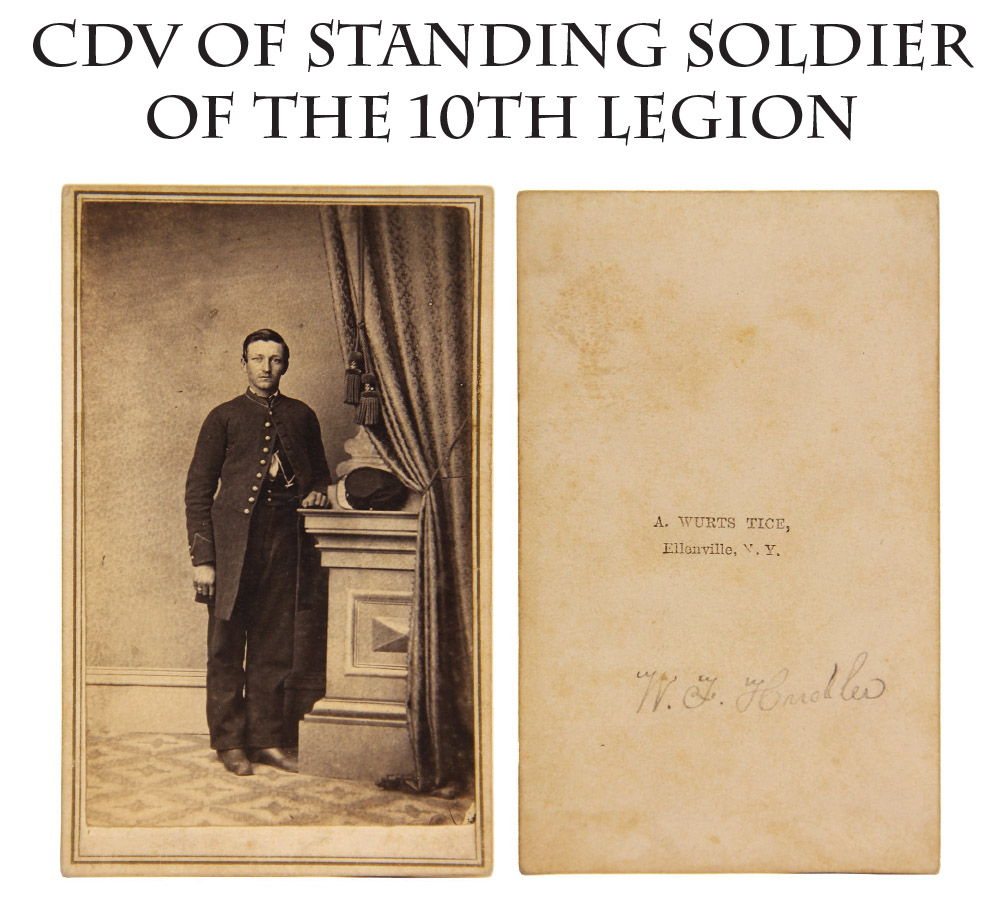
14-04-34 … CDV of Standing Soldier of the 10th Legion …
56th New York Soldier: The Tenth Legion! Full length standing view of a private in his dress infantry frock, open from the throat showing a dark vest and watch chain with dark trousers resting one arm on a column next to him and his forage cap on its side next to him. Tice, photographer, backmark and period pencil identification on reverse: “W.F. Hudler.” I bought this as part of New York Tenth Legion collection and the name checks out as Wilbur F. Hudler, who enlisted at age 18 in Monticello, NY, on 9/23/61 and mustered into Co. K as a private on 10/10/61. He reenlisted as a veteran 2/21/64, and served until mustered out 10/17/65 at Charleston, SC. He died in 1921 in Rockford, Illinois.
The 56th New York had the nickname of Tenth Legion in honor of Julius Caesar’s famous outfit and because they were recruited, like a Roman legion, as a combined arms unit with artillery and cavalry companies attached to them. These companies were split off as separate organizations to bring the unit into line with standard tables of organization, but not before the state had furnished a rather unique uniform: the state volunteer jacket with a shield on one breast containing a big “X” (the Roman numeral ten.) Hudler perhaps had his photo taken when home on furlough and had since switched to more regulation garb. The regiment served in the Fourth Corps, Army of the Potomac, with whom it suffered more than 15 killed and 22 wounded at Fair Oaks during the Peninsula Campaign, until late 1862 when it was assigned to the Department of North Carolina and then the Department of the South, serving in the 18th and the 10th Corps, serving at Charleston and the siege of Ft. Wagner, etc. It suffered another 10 killed at Honey Hill, SC, and other losses at various engagements such as the fights at Deveaux’s Neck, SC, over a period of days in late 1864, losing in all during its service 64 officers and men killed or mortally wounded
… $125.00 SOLD
Click Here to E-mail Us!
Call us @ 419-842-1863
14-03-35UP … Early War brown, brown, brown, russet leather cap box …
Excellent condition with sheep’s wool lining intact. Early scalloped bottom, square flap design as seen on most Confederate examples and on very early war US specimens. Top notch and very scarce. All sewn construction. No rivets… Perfect for CSA display at a fraction the cost of a rebel made box
… $235.00 SOLD
———————
14-04-36UP … Near Mint US Cap Box
with sheep’s wool lining and nipple pick still inside. Crisp inspector’s mark. Superb finish with just a couple blemishes in the leather. Rates a 9.5 on a scale of 10
… $250.00
Click Here to E-mail Us!
Call us @ 419-842-1863
Layaways are Welcome
Need to split your order into multiple payments? No problem! A simple 20% earnest money deposit will hold your item for you.-acf
You can then pay it off in easy installments that fit your budget.
Read Terms Here
Items to Sell? Contact Us
I am always interested in buying ANYTHING from the American Civil War… Guns, Swords, Civil War Muskets, Knives, Uniforms, Flags, Medals, Badges, Diaries, Letters, Autographs, Buttons, photographs, tintypes, daguerreotypes, Insignia, Camp Items, Battlefield Relics, canteens, Drums, Etc… Call 419-842-1863 and ask for Dave Taylor.

